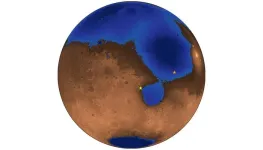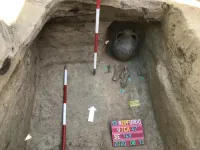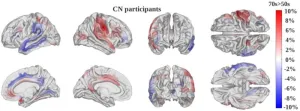(Press-News.org) Ribonucleic acid, commonly known as RNA, is involved in many biological functions, and some, including gene silencing, are utilitized to cure diseases. RNA has recently gained attention as a promising drug target. Unfortunately, only a small fraction of RNA structures have been determined experimentally, and the process of uncovering these structures requires significant time and effort. Using this time scale, the structures of many life saving RNA may not be discovered for years. As a result, there is a significant gap between the types of known RNA and the available structural data.
Researchers at Purdue University have developed a computational solution to this problem named NuFold, which will model 3D RNA structures that could expedite medical discovery decades ahead of schedule. The research team, led by Daisuke Kihara, professor of biological sciences and computer science in the Purdue College of Science, published their findings in Nature Communications.
This result has wide-ranging potential applications, such as in understanding RNA mechanisms and in drug development for diseases involving RNA. NuFold’s code and Google Colab notebook are publicly available, making it accessible not only to researchers but also to anyone interested in RNA structural models. NuFold is a groundbreaking tool for more accurate and efficient RNA structure prediction, with the potential to significantly advance RNA research.
In order to sustain life, varieties of molecules need to work together. Proteins in these molecules have typically been the primary focus of research, but recently RNA has been found to play unique and broad roles in essential life functions. To understand how RNA functions, it is essential for scientists to know its 3D structure.
Kihara studies protein tertiary structure prediction/comparison, protein-protein docking, protein-ligand docking, protein function prediction, protein sequence analysis, and metabolic/regulatory pathway analysis in the Structural Biology Group within the Department of Biological Sciences. His team is affiliated with the Purdue Institute for Cancer Research and also works closely with the Rosen Center for Advanced Computing (RCAC).
“NuFold is the RNA equivalent of AlphaFold. AlphaFold is the computational protein structure prediction method, which got the Nobel Prize in chemistry in 2024,” said Kihara. “AlphaFold is now routinely used in many biology labs. NuFold would be an RNA version of AlphaFold. So, in a way, we’re extending the breakthrough of AlphaFold into the world of RNA, which has been much more challenging to tackle. By modeling RNA's 3D structure, we can help bridge the gap created by the lack of experimentally determined structures, advancing research on RNA and its crucial roles in life and health.”
“It took over three years to develop NuFold,” said Yuki Kagaya, main developer of NuFold and postdoctoral research assistant at Purdue. “A key feature of NuFold is how it represents RNA internally, considering the base pairs that are pivotal to the structure while accurately capturing RNA's inherent flexibility. In benchmark tests, NuFold has outperformed traditional energy-based methods and shown better accuracy in local structure prediction compared to recent deep learning-based approaches.”
NuFold will help researchers “visualize” how RNA structure would look and boost research progress and drug development with RNA.
“To solve problems that cannot be immediately addressed through experiments, we developed NuFold as a computational solution,” said Kihara. “NuFold can help bridge the gap by predicting the 3D structures of RNA from its sequence. By leveraging state-of-the-art machine learning techniques, NuFold can predict the full atomic structure of RNA given its sequence.”
The research authors are all affiliated with Purdue. Kihara is the lead author, who conceived of and directed the study. Other authors include Kagaya, Zicong Zhang (graduate student, computer science), Nabil Ibtehaz (graduate student,computer science), Xiao Wang (former graduate student, computer science), Tsukasa Nakamura (postdoc, biological sciences) and Pranav Deep Punuru (undergraduate student, biological sciences). Kagaya is the main developer, and the rest of the team participated in coding and benchmarking and developing the Google Colab web server.
“The current research was a team effort within our lab, bringing together students and postdocs in computer science and biology. It was enabled by computer resources at RCAC, Purdue the NSF XSEDE (now ACCESS, or Advanced Cyberinfrastructure Coordinator Ecosystem) program and also received support from the Oracle for Research Cloud Grant,” said Kihara.
This work is supported in part by the National Institutes of Health (R01GM133840, R01GM123055) and the National Science Foundation (CMMI1825941, MCB1925643, IIS2211598, DMS2151678, DBI2003635, and DBI2146026). A part of the computation in this work was performed with support from Oracle for Research Cloud Grant (CPQ-3035339), and Extreme Science and Engineering Discovery Environment (XSEDE), which is supported by National Science Foundation grant number ACI-1548562.
About the Department of Biological Sciences at Purdue University
The Department of Biological Sciences is the largest life sciences department at Purdue University. As part of Purdue One Health, we are dedicated to pioneering scientific discoveries and transformative education at the cutting edge of innovation. From molecules to cells, from tissues to organisms, from populations to ecosystems — we bring together multiple perspectives, integrating across biological scales to advance our understanding of life and tackle the world’s most pressing challenges. Learn more at bio.purdue.edu.
About the Department of Computer Science at Purdue University
Founded in 1962, the Department of Computer Science was created to be an innovative base of knowledge in the emerging field of computing as the first degree-awarding program in the United States. The department continues to advance the computer science industry through research. US News & World Report ranks the department No. 8 in computer engineering and No. 18 and 19 overall in undergraduate and graduate computer science. Additionally the program is ranked No. 6 in cybersecurity, No. 8 in software engineering, No. 13 in systems, No. 15 in programming languages and data analytics, and No. 18 in theory. Graduates of the program are able to solve complex and challenging problems in many fields. Our consistent success in an ever-changing landscape is reflected in the record undergraduate enrollment, increased faculty hiring, innovative research projects, and the creation of new academic programs. The increasing centrality of computer science in society, academic disciplines and new research activities—centered around foundations and applications of artificial intelligence and machine learning, such as natural language processing, human computer interaction, vision, and robotics, as well as systems and security—are the future focus of the department. Learn more at cs.purdue.edu.
About Purdue University
Purdue University is a public research university leading with excellence at scale. Ranked among top 10 public universities in the United States, Purdue discovers, disseminates and deploys knowledge with a quality and at a scale second to none. More than 107,000 students study at Purdue across multiple campuses, locations and modalities, including more than 58,000 at our main campus in West Lafayette and Indianapolis. Committed to affordability and accessibility, Purdue’s main campus has frozen tuition 13 years in a row. See how Purdue never stops in the persistent pursuit of the next giant leap — including its comprehensive urban expansion, the Mitch Daniels School of Business, Purdue Computes and the One Health initiative — at https://www.purdue.edu/president/strategic-initiatives.
Contributor: Daisuke Kihara, professor of Biological Sciences and Computer Science at the Purdue University College of Science
Yuki Kagaya, postdoc Biological Sciences at the Purdue University College of Science
Writer: Cheryl Pierce, Lead Marketing and Public Relations Specialist for the Purdue University College of Science
END
Researchers advance RNA medical discovery decades ahead of schedule
Their program, NuFold, will use computational modeling to help bridge the gap of scarcity in library of RNA structures
2025-02-24
ELSE PRESS RELEASES FROM THIS DATE:
Immune ‘fingerprints’ aid diagnosis of complex diseases in Stanford Medicine study
2025-02-24
Your immune system harbors a lifetime’s worth of information about threats it’s encountered — a biological Rolodex of baddies. Often the perpetrators are viruses and bacteria you’ve conquered; others are undercover agents like vaccines given to trigger protective immune responses or even red herrings in the form of healthy tissue caught in immunological crossfire.
Now researchers at Stanford Medicine have devised a way to mine this rich internal database to diagnose diseases as diverse as diabetes COVID-19 responses to influenza vaccines. Although they envision the approach as a way to screen for multiple diseases ...
Ancient beaches testify to long-ago ocean on Mars
2025-02-24
A Chinese rover that landed on Mars in 2021 detected evidence of underground beach deposits in an area thought to have once been the site of an ancient sea, providing further evidence that the planet long ago had a large ocean.
The now-inactive rover, called Zhurong, operated for a year, between May 2021 and May 2022. It traveled 1.9 kilometers (1.2 miles) roughly perpendicular to escarpments thought to be an ancient shoreline from a time — 4 billion years ago — when Mars had a thicker atmosphere and a warmer climate. Along its path, the rover used ground penetrating radar (GPR) to probe up to 80 meters (260 feet) beneath the surface. This ...
Gulf of Mars: Rover finds evidence of ‘vacation-style’ beaches on Mars
2025-02-24
UNIVERSITY PARK, Pa. — Mars may have once been home to sun-soaked, sandy beaches with gentle, lapping waves according to a new study published today (Feb. 24) in the Proceedings of the National Academy of Sciences (PNAS).
An international team of scientists, including Penn State researchers, used data from the Zhurong Mars rover to identify hidden layers of rock under the planet’s surface that strongly suggest the presence of an ancient northern ocean. The new research offers the clearest evidence yet that the planet ...
MSU researchers use open-access data to study climate change effects in 24,000 US lakes
2025-02-24
Feb. 24, 2025
MSU has a satellite uplink/LTN TV studio and Comrex line for radio interviews upon request.
Contact: Emilie Lorditch: 517-355-4082, lorditch@msu.edu
Images
MSU researchers use open-access data to study climate change effects in 24,000 US lakes
EAST LANSING, Mich. – Each summer, more and more lake beaches are forced to close due to toxic algae blooms. While climate change is often blamed, new research suggests a more complex story: climate interacts with human activities like agriculture and urban runoff, which funnel excess ...
More than meets the eye: An adrenal gland tumor is more complex than previously thought
2025-02-24
Fukuoka, Japan - Kyushu University researchers have uncovered a surprising layer of complexity in aldosterone-producing adenomas (APAs)—adrenal gland tumors that drive high blood pressure. Using cutting-edge analysis techniques, they discovered that these tumors harbor at least four distinct cell types, including ones that produce cortisol, the body’s main stress hormone. Published in the week beginning 24 February in PNAS, their findings not only explain why some patients with APAs develop unexpected health issues, like weakened bones, but also pave the way toward new treatment strategies.
“Currently, the only ...
Origin and diversity of Hun Empire populations
2025-02-24
The Huns suddenly appeared in Europe in the 370s, establishing one of the most influential although short-lived empires in Europe. Scholars have long debated whether the Huns were descended from the Xiongnu. In fact, the Xiongnu Empire dissolved around 100 CE, leaving a 300-year gap before the Huns appeared in Europe. Can DNA lineages that bridge these three centuries be found?
To address this question, researchers analyzed the DNA of 370 individuals that lived in historical periods spanning around 800 years, from 2nd century BCE to 6th century CE, encompassing sites in the Mongolian steppe, Central Asia, and the Carpathian Basin of Central Europe. ...
New AI model measures how fast the brain ages
2025-02-24
A new artificial intelligence model measures how fast a patient’s brain is aging and could be a powerful new tool for understanding, preventing and treating cognitive decline and dementia, according to USC researchers.
The first-of-its-kind tool can non-invasively track the pace of brain changes by analyzing magnetic resonance imaging (MRI) scans. Faster brain aging closely correlates with a higher risk of cognitive impairment, said Andrei Irimia, associate professor of gerontology, biomedical engineering, quantitative ...
This new treatment can adjust to Parkinson's symptoms in real time
2025-02-24
Starting today, people with Parkinson’s disease will have a new treatment option, thanks to U.S. Food and Drug Administration approval of groundbreaking new technology.
The therapy, known as adaptive deep brain stimulation, or aDBS, uses an implanted device that continuously monitors the brain for signs that Parkinson’s symptoms are developing. When it detects specific patterns of brain activity, it delivers precisely calibrated electric pulses to keep symptoms at bay.
The FDA approval covers two treatment algorithms that run on a device made by Medtronic, a medical device company. Both work by monitoring the same part of the brain, called the subthalamic nucleus. ...
Bigger animals get more cancer, defying decades-old belief
2025-02-24
Elephants, giraffes, pythons and other large species have higher cancer rates than smaller ones like mice, bats, and frogs, a new study has shown, overturning a 45-year-old belief about cancer in the animal kingdom.
The research, conducted by researchers from the University of Reading, University College London and The Johns Hopkins University School of Medicine, examined cancer data from 263 species across four major animal groups - amphibians, birds, mammals and reptiles. The findings challenge "Peto's paradox," a longstanding idea based on observations from 1977 that suggested ...
As dengue spreads, researchers discover a clue to fighting the virus
2025-02-24
LA JOLLA, CA—Children who experience multiple cases of dengue virus develop an army of dengue-fighting T cells, according to a new study led by scientists at La Jolla Institute for Immunology (LJI).
The findings, published recently in JCI Insights, suggest that these T cells are key to dengue virus immunity. In fact, most children who experienced two or more dengue infections showed very minor symptoms—or no symptoms at all—when they caught the virus again.
"We saw a significant T cell response in children who had been infected more than once before," says study leader and LJI Assistant Professor Daniela Weiskopf, Ph.D.
Dengue virus infects up ...
LAST 30 PRESS RELEASES:
Making lighter work of calculating fluid and heat flow
Normalizing blood sugar can halve heart attack risk
Lowering blood sugar cuts heart attack risk in people with prediabetes
Study links genetic variants to risk of blinding eye disease in premature infants
Non-opioid ‘pain sponge’ therapy halts cartilage degeneration and relieves chronic pain
AI can pick up cultural values by mimicking how kids learn
China’s ecological redlines offer fast track to 30 x 30 global conservation goal
Invisible indoor threats: emerging household contaminants and their growing risks to human health
Adding antibody treatment to chemo boosts outcomes for children with rare cancer
Germline pathogenic variants among women without a history of breast cancer
Tanning beds triple melanoma risk, potentially causing broad DNA damage
Unique bond identified as key to viral infection speed
Indoor tanning makes youthful skin much older on a genetic level
Mouse model sheds new light on the causes and potential solutions to human GI problems linked to muscular dystrophy
The Journal of Nuclear Medicine ahead-of-print tip sheet: December 12, 2025
Smarter tools for peering into the microscopic world
Applications open for funding to conduct research in the Kinsey Institute archives
Global measure underestimates the severity of food insecurity
Child survivors of critical illness are missing out on timely follow up care
Risk-based vs annual breast cancer screening / the WISDOM randomized clinical trial
University of Toronto launches Electric Vehicle Innovation Ontario to accelerate advanced EV technologies and build Canada’s innovation advantage
Early relapse predicts poor outcomes in aggressive blood cancer
American College of Lifestyle Medicine applauds two CMS models aligned with lifestyle medicine practice and reimbursement
Clinical trial finds cannabis use not a barrier to quitting nicotine vaping
Supplemental nutrition assistance program policies and food insecurity
Switching immune cells to “night mode” could limit damage after a heart attack, study suggests
URI-based Global RIghts Project report spotlights continued troubling trends in worldwide inhumane treatment
Neutrophils are less aggressive at night, explaining why nighttime heart attacks cause less damage than daytime events
Menopausal hormone therapy may not pose breast cancer risk for women with BRCA mutations
Mobile health tool may improve quality of life for adolescent and young adult breast cancer survivors
[Press-News.org] Researchers advance RNA medical discovery decades ahead of scheduleTheir program, NuFold, will use computational modeling to help bridge the gap of scarcity in library of RNA structures




